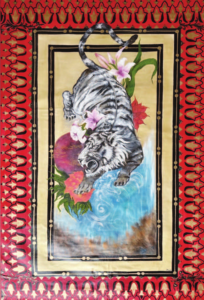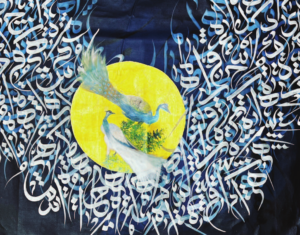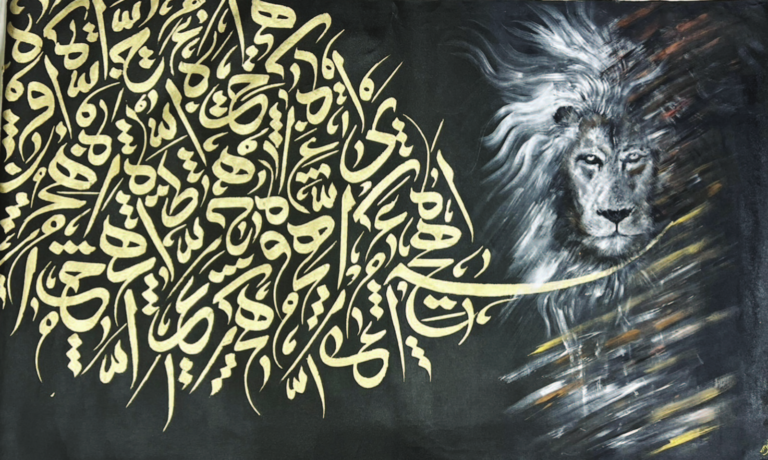Novin Ajmal Malik weaves poetry with art to create stunning masterpieces that capture the spirit of Lahore.
1. How did your artistic journey begin and what are your sources of inspiration?
I’ve always been inclined towards art. As a child, even my science textbooks were filled with art, so it was unsurprising that I chose to study fine arts at Lahore College and National College of Art (NCA) – the best art school in Pakistan. NCA gave me the opportunity to achieve my dream and become an artist/miniaturist.Ghalib and Faiz Ahmad Faiz have always been my biggest inspirations. An amalgamation of art and shayari is my preferred form of expression, as I believe the soul and juzz of every sher is a reflection of art. This poetry-meets-art journey basically started from the ghazal, ‘Wafa Kaisi Kahan Ka Ishq’(Ghalib).

2. How do you feel about bringing your art to Lahore?
I was born in Lahore and am proud of being a Lahori. Lahore has always been in my heart and will continue to stay there forever. I may live in the UK today, but Lore Lore Aaye!
Despite the fact that my work’s been exhibited many a times in London, New York, Warsaw and Glossop, I wanted to launch myself as a commercial artist in Lahore. I proudly say that this breakthrough was given to me by my sister, Rubia Moghees, who took my work to a different height and gave me the visibility one can only dream of. I totally recommend her in this creative space.
Last but not the least, I want to thank my supportive sister Mariam and my family, especially my husband, Ajmal, who is truly my biggest strength.

3. What makes your art resonate with the local audience?
My art resonates with the local audience because it features simple Urdu words with some striking hues and colours, along with strong old miniature images.

4. Miniature art often involves intricate details. Can you elaborate on the techniques and processes you use to create such finely detailed pieces?
Miniature paintings have their own hadd and adaabs; from the extensive method of making paper by layering with lai and adding neela dhotha (sulphur nitrate), to making brushes from squirrels’ tails, to a special technique of safaida. The border of a miniature painting is called jidwal and the technique of painting on it is called pardakht (applying one stroke each time) by balancing tones.
5. Your latest work draws inspiration from Mirza Ghalib’s poetry. Was there anything in particular from his incredible body of work that’s close to your heart?
Just this: “bazicha-e-atfal hai duniya mirey aagey / hota hai shab-o-roz tamasha mirey aagey.” Nothing more to say. As reflected in of one of my paintings titled, “Lafzon Sey Aagey.”

6. Having exhibited globally, have you noticed any cultural influences on your work and has your work evolved through these experiences?
There’s a massive difference between the eastern and western art scene. Over there, contemporary and abstract art sell more, while here, the commercial market is picking up. In the past my exhibitions have featured taboo issues such as honor killing, sexual abuse of children and the sarcasm of politics around the world, but this time I expanded my palette to a different level and focused on breaking boundaries.
7. Lahore has a rich history and artistic tradition. How does the city’s cultural heritage shape your current exhibition and did it inspire any specific pieces?
Lahore, again I would say, meray dil dey wich vasda ay (Lahore lives in my heart). So yes, it has definitely inspired me. One of my pieces that’s titled ‘Chaap’ depicts the intricate Mughal design seen on buildings such as the Lahore Fort and Sheesh Mahal.

8. Can you share a memorable experience or encounter from your previous exhibitions?
Oh yes! My last exhibition in London was titled “King Of The Road,” and was inspired by Pakistani truck art. A foreigner guest, I guess he was Spanish, walked up to me to chat about my work and asked whether my exhibition was inspired by Dolce & Gabbana’s recent collection of home appliances.
It totally cracked me up. I had to tell him about the beautiful art on our trucks by local artisans. I also told him how D&G’s collection was also inspired by our tradition.
9. The scale of miniature art often requires immense patience. How long does it take you to finish a piece?
An authentic miniature painting goes through a strenuous process and needs patience of a different level. One single painting can take up to 2-3 weeks to finish with perfection.
10. What advice would you give to aspiring miniature artists, and how do you see the future of this art form evolving on a global scale?
My advice to upcoming miniature artists is to continue working hard even if they feel down sometimes due to hiccups in the art market. Once your art starts to pick up, there will be no looking back.



